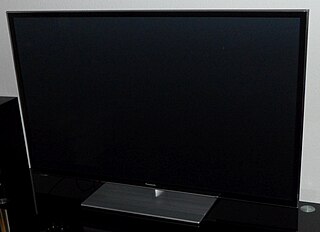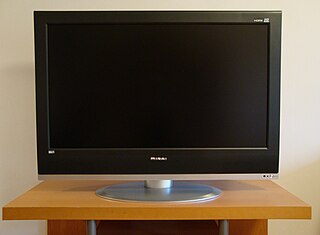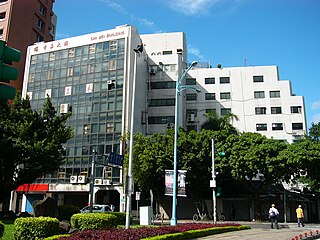
A liquid-crystal display (LCD) is a flat-panel display or other electronically modulated optical device that uses the light-modulating properties of liquid crystals combined with polarizers. Liquid crystals do not emit light directly but instead use a backlight or reflector to produce images in color or monochrome. LCDs are available to display arbitrary images or fixed images with low information content, which can be displayed or hidden: preset words, digits, and seven-segment displays are all examples of devices with these displays. They use the same basic technology, except that arbitrary images are made from a matrix of small pixels, while other displays have larger elements. LCDs can either be normally on (positive) or off (negative), depending on the polarizer arrangement. For example, a character positive LCD with a backlight will have black lettering on a background that is the color of the backlight, and a character negative LCD will have a black background with the letters being of the same color as the backlight. Optical filters are added to white on blue LCDs to give them their characteristic appearance.

Price fixing is an anticompetitive agreement between participants on the same side in a market to buy or sell a product, service, or commodity only at a fixed price, or maintain the market conditions such that the price is maintained at a given level by controlling supply and demand.
Collusion is a deceitful agreement or secret cooperation between two or more parties to limit open competition by deceiving, misleading or defrauding others of their legal right. Collusion is not always considered illegal. It can be used to attain objectives forbidden by law; for example, by defrauding or gaining an unfair market advantage. It is an agreement among firms or individuals to divide a market, set prices, limit production or limit opportunities. It can involve "unions, wage fixing, kickbacks, or misrepresenting the independence of the relationship between the colluding parties". In legal terms, all acts effected by collusion are considered void.

A plasma display panel (PDP) is a type of flat panel display that uses small cells containing plasma: ionized gas that responds to electric fields. Plasma televisions were the first large flat panel displays to be released to the public.

Liquid-crystal-display televisions are television sets that use liquid-crystal displays to produce images. They are by far the most widely produced and sold television display type. LCD TVs are thin and light, but have some disadvantages compared to other display types such as high power consumption, poorer contrast ratio, and inferior color gamut.
A thin-film-transistor liquid-crystal display is a variant of a liquid-crystal display that uses thin-film-transistor technology to improve image qualities such as addressability and contrast. A TFT LCD is an active matrix LCD, in contrast to passive matrix LCDs or simple, direct-driven LCDs with a few segments.

AUO Corporation is a Taiwanese company that specialises in optoelectronic solutions. It was formed in September 2001 by the merger of Acer Display Technology, Inc. and Unipac Optoelectronics Corporation. AUO offers display panel products and solutions, and in recent years expanded its business to smart retail, smart transportation, general health, solar energy, circular economy and smart manufacturing service.

In 2002, the United States Department of Justice, under the Sherman Antitrust Act, began a probe into the activities of dynamic random-access memory (DRAM) manufacturers in response to claims by US computer makers, including Dell and Gateway, that inflated DRAM pricing was causing lost profits and hindering their effectiveness in the marketplace.

CHIMEI Corporation is a Taiwan-based performance materials company. It has long been known as the world’s largest vendor of ABS resins. It has factories in Tainan, Zhenjiang and Zhangzhou. It also produces advanced polymer materials, synthetic rubbers, and specialty chemicals.
LG Display is one of the world's largest manufacturers and supplier of thin-film transistor liquid crystal display (TFT-LCD) panels, OLEDs and flexible displays. LG Display is headquartered in Seoul, South Korea, and currently operates nine fabrication facilities and seven back-end assembly facilities in Korea, China, Poland and Mexico.
The lysine price-fixing conspiracy was an organized effort during the mid-1990s to raise the price of the animal feed additive lysine. It involved five companies that had commercialized high-tech fermentation technologies, including American company Archer Daniels Midland (ADM), Japanese companies Ajinomoto and Kyowa Hakko Kogyo, and Korean companies Sewon America Inc. and Cheil Jedang Ltd. A criminal investigation resulted in fines and three-year prison sentences for three executives of ADM who colluded with the other companies to fix prices. The foreign companies settled with the United States Department of Justice Antitrust Division in September through December 1996. Each firm and four executives from the Asian firms pleaded guilty as part of a plea bargain to aid in further investigation against ADM. The cartel had been able to raise lysine prices 70% within their first nine months of cooperation.

HannStar Display Corporation is a Taiwan-based technology company, primarily involved in the research and production of monitors, notebook displays, and televisions.
Illinois Brick Co. v. Illinois, 431 U.S. 720 (1977), is a United States Supreme Court case that involved issues concerning statutory standing in antitrust law.
The De Beers diamonds antitrust class action sought to end an alleged 60-year conspiracy to fix the price of rough diamonds in the U.S. by the De Beers group of companies. The litigation includes several cases including Hopkins v. De Beers Centenary A.G., et al., No. CGC-04-432954, which commenced on July 24, 2004, and Sullivan v. DB Investments, No. 04-cv-02819, and earlier related cases that commenced in 2001.

Sharp Corporation is a Japanese electronics company. It is headquartered in Sakai, Osaka and was founded by Tokuji Hayakawa in 1912 in Honjo, Tokyo and established as the Hayakawa Metal Works Institute in Abeno, Osaka in 1924. Since 2016, it is majority owned by Taiwan-based manufacturer Hon Hai Precision Industry Co., Ltd., better known as Foxconn.
IPS is a screen technology for liquid-crystal displays (LCDs). In IPS, a layer of liquid crystals is sandwiched between two glass surfaces. The liquid crystal molecules are aligned parallel to those surfaces in predetermined directions (in-plane). The molecules are reoriented by an applied electric field, whilst remaining essentially parallel to the surfaces to produce an image. It was designed to solve the strong viewing angle dependence and low-quality color reproduction of the twisted nematic field effect (TN) matrix LCDs prevalent in the late 1980s.

United States v. Archer Daniels Midland Co. was a criminal case filed on October 15, 1996 in which the United States alleged that Archer Daniels Midland Company (ADM) and other corporations and individuals engaged in a conspiracy to fix and maintain prices of lysine and citric acid and to restrain or eliminate competing suppliers of these additives in violation of Section 1 of the Sherman Antitrust Act. ADM entered into a plea agreement in which ADM pleaded guilty to both antitrust counts and agreed to pay a combined fine of $100 million. This is equivalent to $199.70 million in present-day terms and was at the time the largest antitrust fine ever imposed.
High-Tech Employee Antitrust Litigation is a 2010 United States Department of Justice (DOJ) antitrust action and a 2013 civil class action against several Silicon Valley companies for alleged "no cold call" agreements which restrained the recruitment of high-tech employees.
Economic consulting is the practice of providing advanced economic, financial, and statistical analysis for use in a litigation environment. Law firms, state institutions, and other organizations may rely on economic consultants to produce research, analyses, reports, and testimony to be used in trial.










